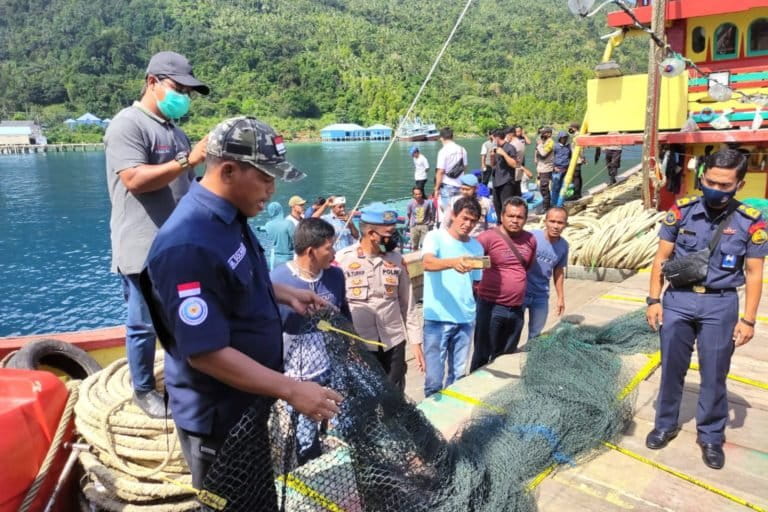- A vessel seized for fishing in an off-limits area in Indonesia may have also been using a type of trawl net that’s been banned for its destructive impact on fish stocks.
- The KM Sinar Samudra was seized off the Natuna Islands on Feb. 18, and a subsequent inspection found a banned cantrang trawl net on board.
- The boat’s captain denied the net was ever used for fishing, and police have chosen not to pursue charges over the use of illegal fishing gear.
- Fisheries observers say the case highlights the challenge of policing the type of gear that fishers use in one of the world’s biggest fishing nations.
NATUNA, Indonesia — A fishing vessel seized by authorities in Indonesia for a zoning violation was doing more than just fishing out of bounds, local fishers allege: it may have been using a destructive type of net that’s banned nationwide.
Local maritime police seized the Indonesian-flagged KM Sinar Samudra on Feb. 18 after finding it fishing within 13 nautical miles (24 kilometers) of the coast of the Natuna Islands. At 130 gross tonnage (GT), the vessel should have been operating at least 30 nautical miles (56 km) offshore, under a fisheries law provision for vessels larger than 30 GT.
An inspection of the vessel found two types of fishing gear on board, one of which appeared to be a cantrang, a trawl net that was initially banned in 2015 for its destructive nature; a 2010 study showed that nearly 50% of cantrang catches were bycatch and discards.


The cantrang ban was provisionally lifted shortly after it came into force, to allow an exemption for fishers from the north coast of Java Island, and was revoked entirely in November 2020. In July 2021, the fisheries ministry reimposed the national ban on cantrang and other destructive fishing gear to protect the country’s valuable marine resources.
The KM Sinar Samudra was among the fleet of north coast Java fishing vessels that were enlisted as an unofficial navy by the Indonesian government to fish with their cantrang nets in the waters around the Natuna Islands between Sumatra and Borneo in late 2019 and early 2020. The move was meant to establish a heavy Indonesian presence there to counter incursions into the area by Chinese fishing boats; while China hasn’t explicitly laid claim to the Natuna waters, its controversial “nine-dash line” includes the area, which is acknowledged by the rest of the world as Indonesian waters.
For the KM Sinar Samudra, that means it would have been allowed to use a cantrang net up until last July. Maritime investigators searching the vessel after the zoning violation seizure found it had a cantrang on board, and while the captain confirmed the type of net, he said it had never been deployed for fishing. Police have chosen not to pursue charges for the use of illegal fishing gear.
“As long as the gear wasn’t used and it was for repair purposes, it’s not a problem,” Sandy Pratama Putra, the chief of the Natuna maritime police, told Mongabay-Indonesia on Feb. 25. He added the case has been handed over to the fisheries ministry for further investigation.
But local fishers in the Natuna Islands, who have clashed with the better-equipped Java fishers since the latter arrived in the region, say the KM Sinar Samudra was undoubtedly using its cantrang to catch fish. Hendri, the chair of the Natuna Fishers Alliance, pointed out that the other net found on board the vessel, with a square mesh rather than the diamond-shaped mesh of a cantrang, “appears clean like new,” despite the KM Sinar Samudra having caught 10 metric tons of fish.
Hendri joined an inspection of the vessel on Feb. 22, where he observed the fishing gear on board.
“The police wouldn’t use the cantrang as evidence because the boat captain claimed it was never used, but would a thief confess to the crime?” Hendri said.
“They would show [port inspectors] the other net but would actually use the cantrang at sea,” he added.


Fisheries observers have called on the ministry to take the KM Sinar Samudra case as a wake-up call to strengthen monitoring of fishing gear at ports and at sea. They say the ministry must carry out an independent scientific study on the actual impacts of the square-meshed tarik berkantong nets that have been approved to replace cantrang.
“Tarik berkantong nets are very similar-looking to cantrang which the government has banned,” said Mohammad Abdi Suhufan, national coordinator for the NGO Destructive Fishing Watch (DFW) Indonesia. “Cantrang fishers can be pretty slick.”
Abdi also called on all fishers to help with monitoring at sea, noting that Indonesia has a dearth of maritime inspectors.
Hendri, the Natuna fisherman, called for a temporary ban on tarik berkantong nets until its impacts on fish stocks and the environment are better understood. “We hope tarik berkantong nets are canceled or put under a moratorium until we know exactly what it is,” he said.
This story was reported by Mongabay’s Indonesia team and first published here and here on our Indonesian site on March 2 and 5, 2022.
FEEDBACK: Use this form to send a message to the author of this post. If you want to post a public comment, you can do that at the bottom of the page.